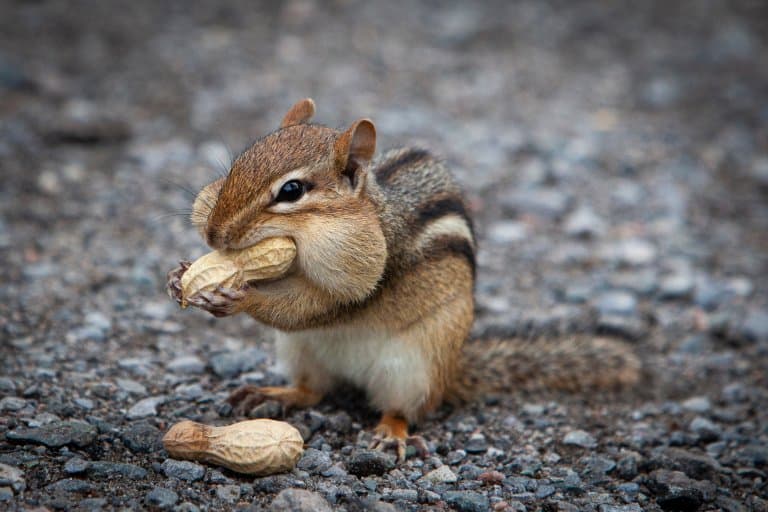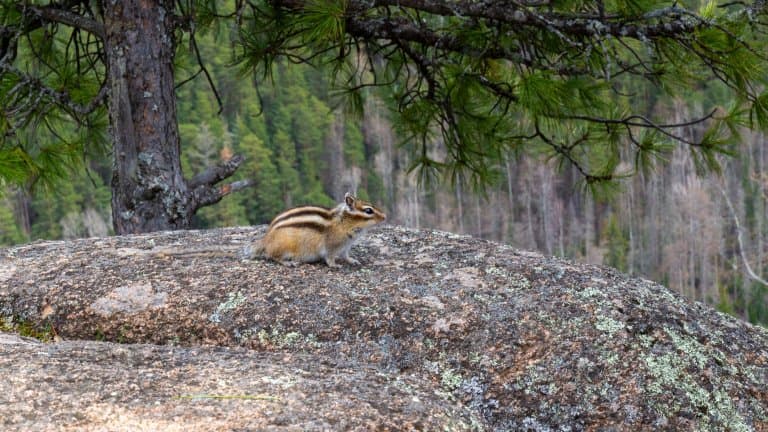Chipmunk Profile
Chipmunks, members of the squirrel family, are found mainly in North America with the sole exception of the Siberian chipmunk, which is found in Asia and some parts of Europe.
All chipmunks have varying black and white stripes running down their backs, have relatively short legs and slightly bushy tails. Chipmunks are often observed with full cheek pouches which allow them to carry large amounts of food back to their burrows.
Chipmunks are adaptable rodents and are found in a variety of habitats across their range. They generally prefer areas with good undergrowth cover beneath largely wooded areas.

Chipmunk Facts Overview
| Habitat: | Variety of habitats from forests to shrubby deserts |
| Location: | North America. One species, the Siberian Chipmunk, found in Asia and parts of Europe |
| Lifespan: | 2 – 5 years in the wild |
| Size: | Eastern chipmunk length incl. tail – 25 cm. Least chipmunk length incl. tail – 18 cm |
| Weight: | Species range from 42g to 142g |
| Color: | Colours range from dark brown to light grey. All species have stripes down their backs and tails and on their face |
| Diet: | Omnivorous, feeding on a variety of seeds, grains, nuts, fruit and berries. Will also eat insects and bird eggs |
| Predators: | Most carnivorous mammals in their habitats as well as snakes and birds of prey |
| Top Speed: | 21 kph (15 mph) |
| No. of Species: |
25 |
| Conservation Status: |
Species range from ‘Least Concern’ to ‘Endangered’ |
In their range chipmunks occupy many different habitats, including alpine meadows, dry scrub and even regions where the temperature remains below freezing through much of the year.
The adaptability of the chipmunk has resulted in the evolution of around 25 different species.
Though spending much of their time on the ground, most chipmunks are agile climbers and will easily climb trees and bushes in search of food. They are quick and alert animals; scurrying through the undergrowth collecting seeds, fruits and nuts in their large cheek pouches.
Most chipmunks live in underground burrows, holes in logs or under rocks. Their burrows are usually rather expansive and can extend underground for many metres. Chipmunks are active during the day but often spend much of it sleeping in their burrows after their frantic search for food.
Chipmunks are generally solitary animals and when not breeding spend much of their time alone. They are not overly territorial and where there is an abundance of a certain food source, several chipmunks may be seen in the same vicinity.
Some species, such as the red-tailed chipmunk, spend large proportions of their time in trees, collecting insects, berries, fruits and nuts from the branches. However the majority of chipmunks are mostly terrestrial but readily climb trees to escape predators or search for food.
Chipmunks are generally omnivorous, though fruits, berries and nuts make up the majority of their diet. They will however feed on insects, fungi, grasses and even bird eggs and frogs.
Chipmunks have a shrill, high pitched call which they mainly use when predators are present or to communicate during the breeding season or during territorial disputes.
Chipmunks give birth to one or two litters during spring and most litters consist of two to eight young. The offspring are entirely dependent on their mother, who provides milk until they are fully fit and ready to explore the surrounding area.
Though small and unobtrusive, chipmunks play a vital role in the ecosystem. They are prolific seed dispersers of many trees and shrubs and play an important role in the spread of beneficial fungi spores. Chipmunks also provide many animals with a source of food and are preyed upon by birds of prey, snakes, weasels, foxes and many other carnivores. 1
Interesting Chipmunk Facts
1. Chipmunks keep their burrows clean and tidy
Some chipmunks have long and complex tunnel systems and the entrance is cleared of all debris. They even have specific tunnels where they leave their droppings and others where food is stored. 2
2. Their cheek pouches can expand 3 times their normal size
Their cheek pouches are able to expand up to three times their normal size and this allows chipmunks to carry relatively huge amounts back to store in their burrows or dens.

3. Chipmunks also carry dirt in their cheek pouches
When either cleaning or escalating their burrows, chipmunks will carry dirt in their cheek pouches and deposit it in specially designed tunnels or out of the den itself. 3
4. Different species have differing stripe patterns
Chipmunks on average have 5 stripes running down their back and two down their sides. The colour and thickness of these stripes varies in different species.
5. They are often confused with ground squirrels
Sometimes confused with ground squirrels, chipmunks have bushier tails, fewer stripes, larger ears and facial stripes.
Ground squirrels are also found more often in open areas and grasslands, where chipmunks prefer more wooded areas.

6. Chipmunks molt their fur twice a year
Chipmunks usually molt twice throughout the year and their winter coat is slightly longer and woollier than their summer one. 4
7. There are pure white and pure black chipmunks
Like many other animals, albino and melanistic chipmunks do occur across their range.
8. Chipmunks sleep up to 15 hours a day
Due to their small size and fast-paced foraging, chipmunks regain their energy by sleeping for long periods during the day.
9. Chipmunks are most active during dusk and dawn
Preferring the cooler hours during warmer months, chipmunks forage during the early morning and late afternoon.

10. The Siberian chipmunk is the only chipmunk found outside North America
Though native to Asia, some Siberian chipmunks are found in parts of Europe also. These populations came about after pet chipmunks escaped or were released.

11. They hibernate all the way through winter
Depending on the location, some chipmunk species hibernate during the winter while others do not. Even those that do hibernate will intermittently awake from hibernation, or torpor, as their body fat alone is not a sufficient enough source of energy during particularly long winters.
Those species that do hibernate spend a very large amount of time feeding during the warmer months in an attempt to put on as much body fat as possible before winter. 5
Chipmunk Fact-File Summary
Scientific Classification
| Kingdom: | Animalia |
| Phylum: | Chordata |
| Class: | Mammalia |
| Order: | Rodentia |
| Family: | Sciuridae |
| Genus: | Eutamias Tamias Neotamias |
| Species Names: |
Siberian chipmunk, Eutamias sibiricus Eastern chipmunk, Tamias striatus Allen’s chipmunk, Neotamias senex Alpine chipmunk, Neotamias alpinus Buller’s chipmunk, Neotamias bulleri California chipmunk, Neotamias obscurus Cliff chipmunk, Neotamias dorsalis Colorado chipmunk, Neotamias quadrivittatus Durango chipmunk, Neotamias durangae Gray-collared chipmunk, Neotamias cinereicollis Gray-footed chipmunk, Neotamias canipes Hopi chipmunk, Neotamias rufus Least chipmunk, Neotamias minimus Lodgepole chipmunk, Neotamias speciosus Long-eared chipmunk, Neotamias quadrimaculatus Merriam’s chipmunk, Neotamias merriami Palmer’s chipmunk, Neotamias palmeri Panamint chipmunk, Neotamias panamintinus Red-tailed chipmunk, Neotamias ruficaudus Siskiyou chipmunk, Neotamias siskiyou Sonoma chipmunk, Neotamias sonomae Townsend’s chipmunk, Neotamias townsendii Uinta chipmunk, Neotamias umbrinus Yellow-cheeked chipmunk, Neotamias ochrogenys Yellow-pine chipmunk, Neotamias amoenus |
Fact Sources & References
- Brittany R. Schweiger (2021), “Weather determines daily activity pattern of an endemic chipmunk with predictions for climate change”, Science Direct.
- David E. Williams (1994), “Chipmunks”, Research Gate.
- (2015), “Chipmunk Facts”, Live Science.
- “Chipmunks”, National Geographic.
- “Eastern Chipmunk-Tamias striatus”, iNaturalist.
